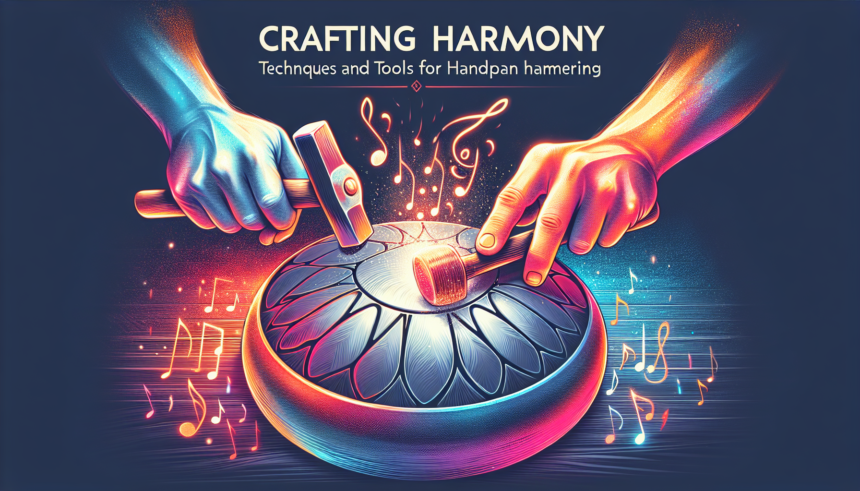The handpan is a mesmerizing instrument known for its ethereal soundscapes, captivating audiences globally. Originating from the Hang, developed in Switzerland by PANArt in the year 2000, the handpan has evolved into a beloved tool for both professional musicians and recreational players. The creation of these remarkable instruments demands meticulous craftsmanship, specifically through a process known as handpan hammering. This article delves into the intricate techniques and essential tools required for handpan hammering, guiding you through the journey of crafting harmony.
The Art of Handpan Hammering
Handpan hammering involves shaping and tuning steel sheets into a pristine musical instrument. The process requires patience, skill, and a deep understanding of acoustics to ensure each note is finely tuned and resonates beautifully. Here, we’ll explore the fundamental techniques and tools necessary for this craft.
1. Selection of Materials
The journey begins with selecting the right type of steel. Most handpans are made from nitrided steel, known for its durability and tonal quality. Nitriding is a heat treatment process that diffuses nitrogen into the surface to create a hard, wear-resistant layer. This makes the steel both responsive and resonant, essential qualities for a handpan.
2. Shaping the Steel
Once the steel is chosen, it needs to be shaped into two hemispheres, known as shells. This is typically done using hydraulic presses or manual hammering. For manual shaping, artisans employ a technique called “dishing,” striking the steel repeatedly to form a domed surface. This requires precision and consistency to avoid any distortions.
3. Creating the Notes
With the basic shape formed, the next step is to mark and create the notes. The layout of the notes is crucial as it impacts playability and tonal harmony. Each note area, known as a “tone field,” is carefully measured and marked. The artisan uses various hammers and anvils to indent the steel, gradually forming the note dimples that will define the pitch.
It’s essential to work methodically, often annealing (heating and cooling) the steel to relieve stresses and prevent cracking. As the note dimples start to form, the artisan must continually check the resonance and adjust the shape accordingly.
4. Fine-Tuning
Fine-tuning is perhaps the most crucial aspect of handpan crafting. Each note needs to resonate clearly and in harmony with others. The tuning process involves repeatedly striking the note areas while listening carefully to the pitch produced. Tuning forks or electronic tuners are frequently used to compare the pitches and ensure accuracy.
Artisans often employ a technique called “shaping” during tuning, which involves subtle modifications to the dimple and the surrounding area to fine-tune the frequencies. This precise work demands a keen ear and deep understanding of acoustic principles.
Essential Tools for Handpan Hammering
Crafting a handpan requires a range of specialized tools. Each tool plays a significant role in the hammering and tuning processes. Here’s a breakdown of some essential tools used by handpan artisans:
1. Hammers
Various types of hammers are used in the creation of a handpan. These include:
- Ball-Pein Hammer: Used for general shaping and dishing of the steel.
- Chasing Hammer: Utilized for more detailed work and creating note dimples.
- Tuning Hammer: Specifically designed for fine-tuning note frequencies.
2. Anvils
Anvils provide the necessary surface against which the steel can be hammered. Different anvils are used for various stages, such as:
- Flat Anvils: Applied during the initial shaping phase.
- Curved Anvils: Essential for forming and shaping note dimples.
3. Tuning Forks/Electronic Tuners
These devices help artisans ensure that each note is in perfect pitch. Tuning forks offer a more traditional approach, while electronic tuners provide precision and ease of use.
4. Measuring Tools
Accurate measurements are critical in marking note areas and ensuring consistency. Calipers and rulers are indispensable tools for this purpose.
5. Heating Equipment
Annealing the steel is necessary to relieve stress and avoid cracks. Heating equipment, such as propane torches, is used to achieve the required temperatures for this process.
Mastering the Craft
Becoming proficient in handpan hammering requires dedication, practice, and an appreciation for the subtle nuances of the instrument. Artisans often spend years perfecting their techniques and developing their unique styles. Here are some key tips for aspiring handpan makers:
1. Patience and Precision
The process of handpan hammering is time-consuming and demands patience. Every strike and adjustment must be made with precision, as even minor errors can impact the tonal quality.
2. Continuous Learning
The journey to mastering handpan hammering is never-ending. Engaging with the handpan community, attending workshops, and learning from experienced artisans can greatly enhance one’s skills.
3. Attention to Acoustics
Understanding acoustic principles is crucial. The interplay between shape, tension, and resonance is complex, and a deep appreciation of these factors will aid in creating harmonious instruments.
4. Experimentation
Don’t hesitate to experiment with different techniques and tools. Sometimes, innovative methods can lead to unique sounds and enhance the overall craftsmanship.
Conclusion
Crafting handpans is a blend of art and science, requiring not just technical skills but also a deep musical intuition. Through meticulous hammering and tuning, artisans breathe life into steel, creating instruments that resonate with harmony and emotion. As the handpan continues to enchant listeners around the world, the dedication and passion of its makers ensure that this remarkable instrument will flourish for generations to come.
FAQs
1. What is a handpan?
A handpan is a musical instrument consisting of two metal hemispheres fused together, with tuned tone fields hammered into the surface. It produces melodic and resonant sounds when played with the hands.
2. How long does it take to make a handpan?
Creating a handpan can take anywhere from several weeks to months, depending on the artisan’s skill level and the specific requirements of the instrument.
3. Can I make a handpan at home?
While it is possible to make a handpan at home, it requires specialized tools, materials, and considerable expertise. Most beginners start by learning from experienced artisans or taking workshops.
4. What materials are used to make a handpan?
Handpans are typically made from nitrided steel, which offers the durability and tonal quality needed for the instrument’s unique sound. Some handpans may also be made from stainless steel or other metal alloys.
5. How do you tune a handpan?
Tuning a handpan involves carefully hammering the note areas to adjust their pitch. This process requires experience and precise listening, often aided by tuning forks or electronic tuners to achieve accurate tones.





